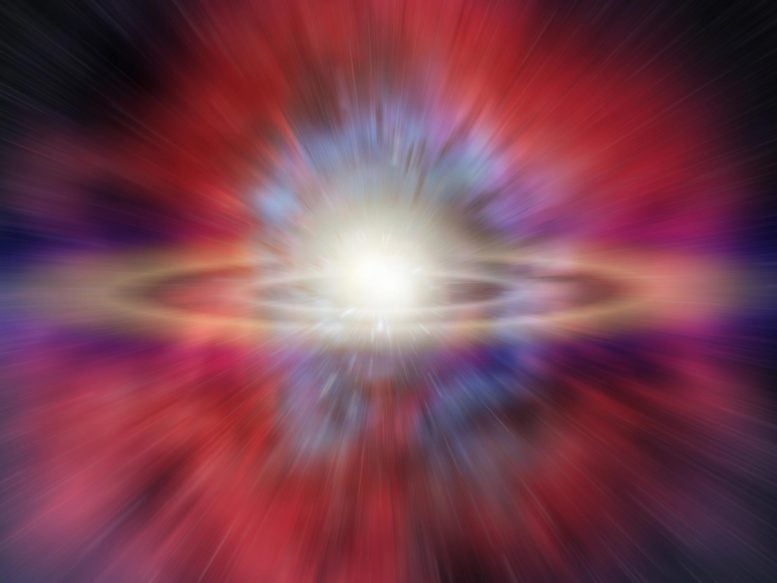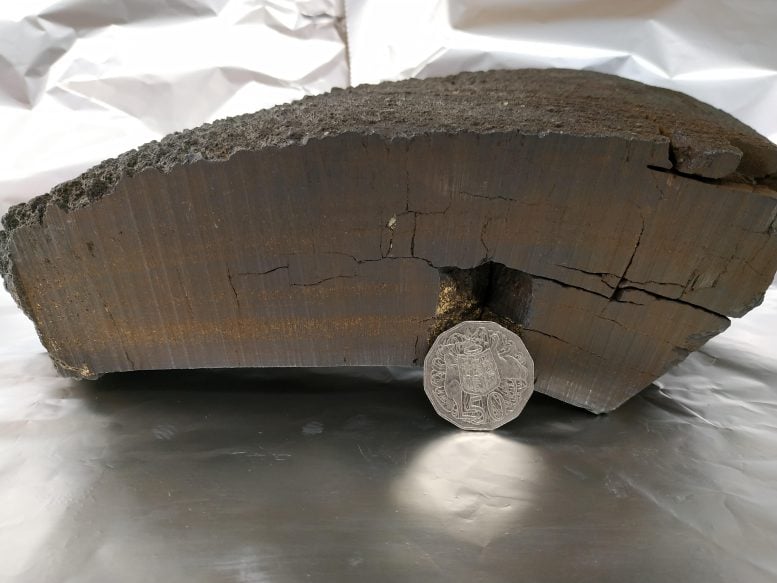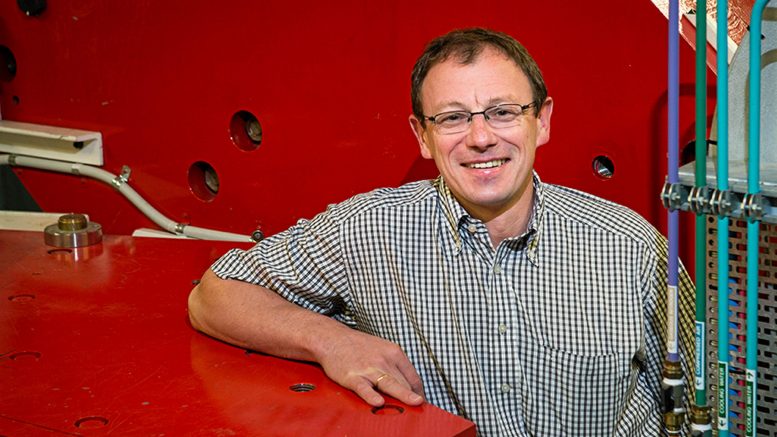
Search for witnesses of near-Earth astrophysical events.
When large stars or celestial bodies explode near Earth, their debris can reach our solar system. Evidence of these cosmic events is found on Earth and the Moon, detectable through accelerator mass spectrometry (AMS). An overview of this exciting research was recently published in the scientific journal Annual Review of Nuclear and Particle Science by Prof. Anton Wallner of the Helmholtz-Zentrum Dresden-Rossendorf (HZDR), who soon plans to decisively advance this promising branch of research with the new, ultrasensitive AMS facility “HAMSTER.”
In their paper, HZDR physicist Anton Wallner and colleague Prof. Brian D. Fields from the University of Illinois in Urbana, USA, provide an overview of near-Earth cosmic explosions with a particular focus on events that occurred three and, respectively, seven million years ago.
“Fortunately, these events were still far enough away, so they probably did not significantly impact the Earth’s climate or have major effects on the biosphere. However, things get really uncomfortable when cosmic explosions occur at a distance of 30 light-years or less,” Wallner explains. Converted into the astrophysical unit parsec, this corresponds to less than eight to ten parsecs.
Once massive stars have burned up all their fuel, their cores collapse into an ultra-dense neutron star or a black hole, while at the same time, hot gas is ejected outward at a high velocity. A large part of the gas and dust finely dispersed between the stars is carried away by an expanding shock wave. Like a giant balloon with bumps and dents, this envelope also sweeps up any material already present in space. After many thousands of years, the remnants of a supernova have expanded to a diameter of several 10 parsecs, spreading out ever more slowly until the motion finally ceases.

A nearby explosion has the potential to severely disrupt the Earth’s biosphere and cause a mass extinction similar to the asteroid impact 66 million years ago. The dinosaurs and many other animal species fell victim to that event. “If we consider the time period since the solar system’s formation, which spans billions of years, very close cosmic explosions cannot be ruled out,” Wallner emphasizes.
Nevertheless, supernovae only occur in very heavy stars with more than eight to ten times the mass of our sun. Such stars are rare. One of the closest candidates of this size is the red supergiant Betelgeuse in the constellation of Orion, located at a safe distance of about 150 parsecs from our solar system.
Production of interstellar isotopes
Many new atoms are generated during cosmic explosions or shortly before and during the supernova – among them also a number of radioactive atoms. Wallner is particularly interested in the radioactive iron isotope with an atomic mass of 60. About half of these isotopes, called iron-60 for short, have turned into a stable nickel isotope after 2.6 million years. Therefore, all iron-60 that was present at the Earth’s formation some 4,500 million years ago has long since disappeared.
“Iron-60 is extremely rare on Earth because, by natural means, it is not produced in any significant amount. However, it is produced in large quantities just before a supernova takes place. If this isotope now turns up in sediments from the ocean floor or in material from the surface of the moon, it probably came from a supernova or another similar process in space that has taken place near Earth only a few million years ago,” Wallner summarizes.

The same applies to the plutonium isotope with an atomic mass of 244. However, this plutonium-244 is more likely generated by the collision of neutron stars than by supernovae. Thus, it is an indicator of the nucleosynthesis of heavy elements. After a period of 80 million years, about half of the plutonium-244 isotope has turned into other elements. Therefore, the slowly decaying plutonium-244 is, in addition to iron-60, another indicator of galactic events and the production of new elements in the last millions of years.
“Exactly how often, where, and under what conditions these heavy elements are produced is currently the subject of intense scientific debate. Plutonium-244 also requires explosive events and, according to theory, is produced similarly to the elements gold or platinum, which have always occurred naturally on Earth but consist of stable atoms today,” Wallner explains.
Dust particles as cosmic cargo vessels
But how do these isotopes get to Earth in the first place? The iron-60 atoms ejected by the supernova like to congregate in dust particles. So do the plutonium-244 isotopes, which were possibly created in other events and swept up by the supernova’s expanding envelope. After cosmic explosions at a distance of more than ten but less than 150 parsecs, according to theory, the solar wind and the magnetic field of the heliosphere prevent individual atoms from reaching the Earth. However, the iron-60 and plutonium-244 atoms trapped in dust particles continue to fly toward the Earth and the Moon, where they can eventually trickle down to the surface.
Even with a supernova occurring within the so-called “kill radius” of less than ten parsecs, not even a microgram of matter from the envelope will land on each square centimeter. In fact, only very few iron-60 atoms per square centimeter reach the Earth each year. This poses an enormous challenge to “investigators” like physicist Anton Wallner: Within a one-gram sediment sample, perhaps a few thousand iron-60 atoms are distributed like needles in a haystack among billions of billions of ubiquitous and stable iron atoms with the atomic mass of 56. On top of that, even the most sensitive measurement method may only detect every five thousandth particle, i.e., a maximum of only a few iron-60 atoms in a typical measurement sample.
Such extremely low concentrations can only be determined with Accelerator Mass Spectrometry, short AMS. One of these facilities, the Dresden AMS (DREAMS), is located at the HZDR, soon to be joined by the Helmholtz Accelerator Mass Spectrometer Tracing Environmental Radionuclides (HAMSTER). Since AMS facilities around the globe are designed differently, the various facilities can complement each other in the search for rare isotopes from supernova explosions.
20 years for just one thousand iron-60 atoms
Isotopes of the same element but with a different mass, like the naturally occurring iron-56, are removed with mass filters. Atoms of other elements with the same mass as the target object iron-60, for example, the naturally occurring nickel-60, also interfere. Even after very complex chemical preparation of the samples, they are still billions of times more abundant than iron-60 and must be separated in a special accelerator facility using nuclear physics methods.
In the end, perhaps five individual iron-60 atoms are identified in a measuring process that lasts several hours. Pioneering work on iron-60 detection was conducted at TU Munich. Presently, however, Canberra at the Australian National University is the only existing facility worldwide that is sensitive enough to perform such measurements.
In total, only about one thousand iron-60 atoms have been measured in the past 20 years. For the interstellar plutonium-244, which occurs in concentrations more than 10,000 times lower, only data for individual atoms were available for a long time. Only recently has it been possible to determine about a hundred plutonium-244 atoms at a specialized infrastructure in Sydney – similar to the HAMSTER facility currently under development at the HZDR.
However, only certain samples are suitable for investigation, which act as archives to preserve these atoms coming from space for millions of years. Samples from the Earth’s surface, for example, are rapidly “diluted” by geological processes. Sediments and crusts from the deep sea, which slowly form undisturbed on the ocean floor, are ideal. Alternatively, samples from the lunar surface are suitable because disruptive processes are hardly a problem.
On a research trip until the beginning of November 2023, Wallner and his colleagues will hunt for further cosmic isotopes at particularly suitable AMS facilities in the Australian cities of Canberra (iron-60) and Sydney (plutonium-244). For this purpose, he has received a number of lunar samples from the U.S. space agency NASA.
“Parallel measurements are also taking place at HZDR. These unique samples will allow us to gain new insights into supernova explosions near Earth, but also into the heaviest elements in our galaxy which are formed through these and other processes,” Wallner is certain.
Reference: “Deep-Sea and Lunar Radioisotopes from Nearby Astrophysical Explosions” by Brian D. Fields and Anton Wallner, September 2023, Annual Review of Nuclear and Particle Science.
DOI: 10.1146/annurev-nucl-011823-045541